The Flavorful Streets of Chiang Mai
Chiang Mai, a city celebrated for its rich cultural heritage, is equally renowned for its vibrant street food culture. This introduction delves into the colorful and flavorful world of Chiang Mai’s street food, a pivotal aspect of local life that tantalizes the taste buds and offers a window into the soul of Northern Thai culture.
Overview of Chiang Mai’s Street Food Culture
The streets of Chiang Mai are a food lover’s paradise, buzzing with a plethora of aromas and flavors that define the essence of Northern Thai cuisine. Street food in Chiang Mai is not just about eating; it’s a cultural experience. Stalls and small eateries line the busy markets and quiet alleys, each offering a unique taste of local delicacies.
From spicy, tangy salads and grilled meats to sweet, sticky desserts, the variety is endless. Signature dishes like Khao Soi (creamy coconut curry noodle soup) and Sai Oua (spicy Northern Thai sausage) are must-tries for anyone wanting to experience the true flavors of the region. The food here tells the story of Chiang Mai’s history, incorporating influences from neighboring countries and ancient traditions.
Importance of Street Food in Local Life
Street food is an integral part of daily life in Chiang Mai. It’s where locals gather, socialize, and enjoy meals that are quick, affordable, and delicious. These street-side eateries are often family-run, with recipes passed down through generations, preserving the authenticity and heritage of Lanna cuisine.
For locals, these dishes are more than just sustenance; they represent a sense of community and continuity. Food vendors take pride in their offerings, with each dish reflecting their personal touch and interpretation of traditional flavors. The bustling street food scene is a testament to the lively spirit and culinary prowess of Chiang Mai’s people.
Tips for Exploring Street Food in Chiang Mai
Venture Beyond the Main Streets: While popular markets like the Night Bazaar are a good start, exploring side streets and local neighborhoods can lead to delightful culinary discoveries.
Follow the Locals: The best street food spots are often where you see a crowd of locals. These are usually the places that serve authentic, high-quality food.
Try a Bit of Everything: Street food is perfect for sampling a variety of dishes. Don’t hesitate to try small portions of different items to experience a range of flavors.
Mind the Hygiene: Look for stalls where the food is prepared fresh in front of you. It’s a good indicator of the food’s hygiene and quality.
Learn a Few Thai Phrases: Knowing basic Thai phrases for ordering food can enhance your experience and help you connect with the vendors.
Be Adventurous with Your Choices: Don’t shy away from trying something new. Dishes that might seem unfamiliar could end up being a delightful surprise.
Respect Local Eating Customs: Observe and respect local customs and manners while eating. It’s part of immersing yourself in the culture.
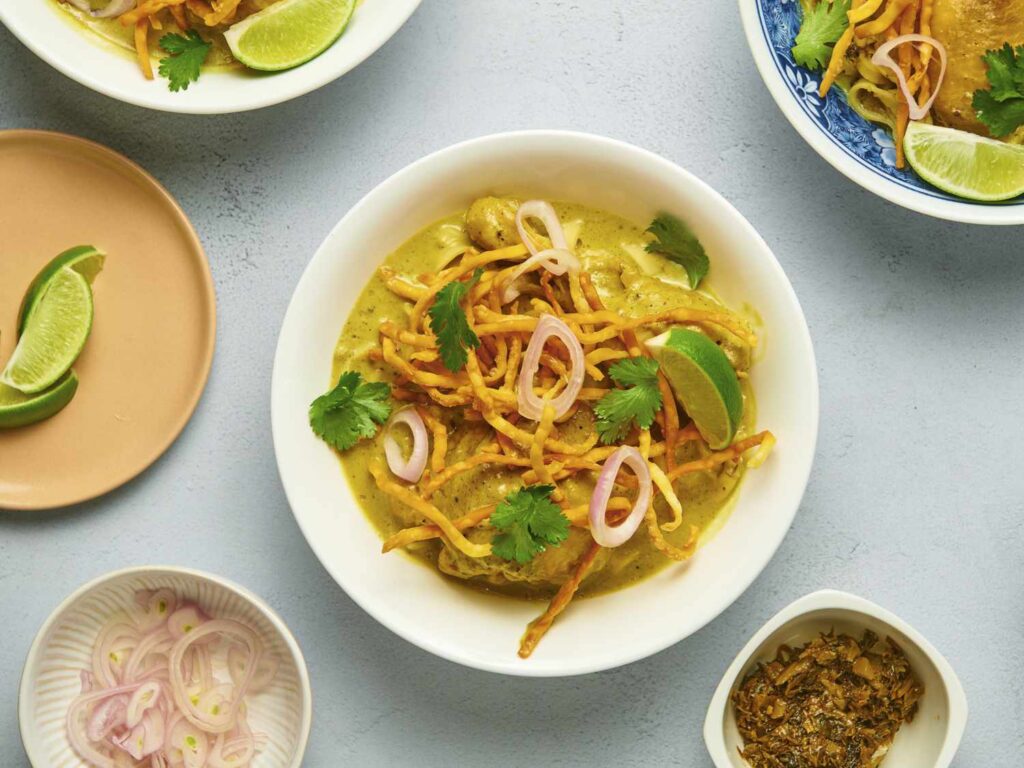

Khao Soi – The Northern Thai Delicacy
Khao Soi, the quintessential Northern Thai dish, is a symphony of flavors and textures that epitomizes the culinary heritage of Chiang Mai. This section delves into the rich history and cultural significance of Khao Soi, guides you to the best places to savor it in Chiang Mai, and explores its unique taste profile and variations.
History and Cultural Significance of Khao Soi
The origins of Khao Soi reflect the melting pot of cultures in Northern Thailand. Influenced by the cuisine of neighboring Myanmar and the Chinese Muslim community, Khao Soi is a delightful blend of local Thai flavors and foreign culinary traditions. The dish became popular in Chiang Mai and has since been synonymous with Lanna culture.
Traditionally, Khao Soi is a hearty, comforting dish. It features soft egg noodles in a rich, creamy coconut milk broth, spiced with a blend of curry flavors unique to Northern Thailand. Topped with crispy fried noodles, it’s a dish that combines texture and taste in perfect harmony. Khao Soi is not just food; it’s a representation of Chiang Mai’s history, its diverse influences, and its culinary ingenuity.
Where to Find the Best Khao Soi in Chiang Mai
Chiang Mai boasts numerous eateries that offer their own take on this iconic dish. Some of the most renowned places to enjoy Khao Soi include:
Khao Soi Lam Duan Fah Ham: Known for its rich and flavorful broth, this establishment has been serving locals and tourists alike for decades.
Khao Soi Khun Yai: A hidden gem located near Wat Kuan Kama, famous for its authentic taste and homely ambiance.
Khao Soi Mae Sai: Offers a more rustic version of the dish, attracting a loyal following for its traditional flavors.
Chiang Mai Gate Market: For a quick and delicious street food version, visit the stalls at this bustling local market.
Each of these places offers a unique experience of Khao Soi, from family-recipe broth to variations in toppings and spice levels.
Tasting Notes and Variations
The key to Khao Soi’s appeal lies in its complex flavor profile. The broth is rich and creamy, usually made with coconut milk, and features a perfect balance of spicy, sour, sweet, and savory notes. The dish is typically served with a plate of condiments – pickled mustard greens, shallots, lime, and ground chilies fried in oil – allowing diners to customize the flavor to their liking.
While the traditional Khao Soi is made with chicken (Khao Soi Gai), variations include beef (Khao Soi Neua), pork, and even vegetarian options. The dish’s versatility and depth of flavor make it a must-try for anyone visiting Chiang Mai.
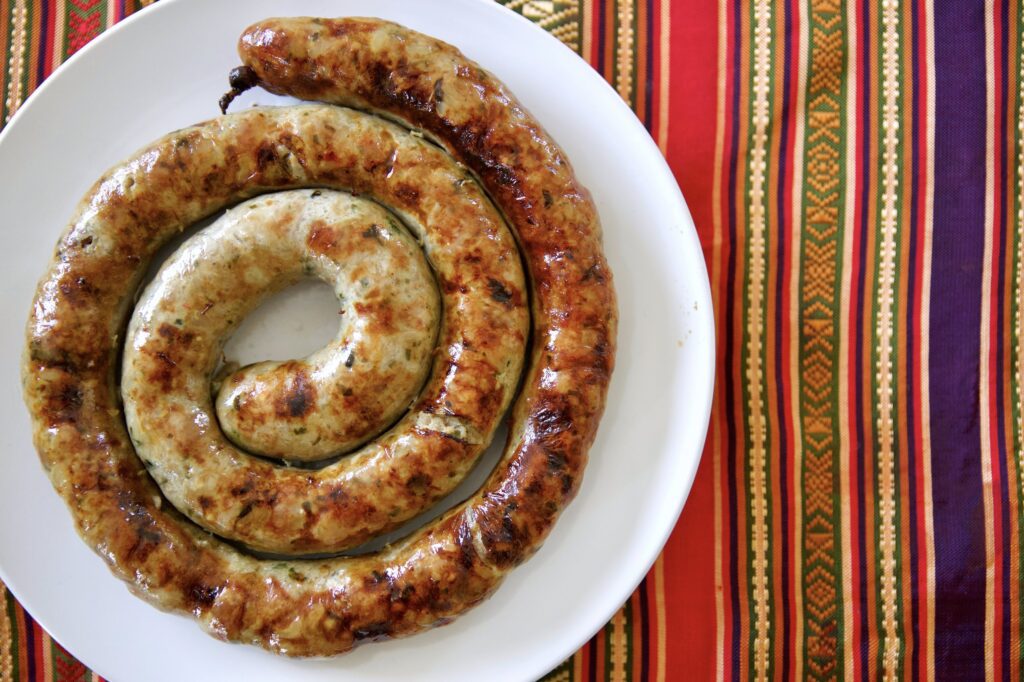

Sai Oua – Grilled Herb Sausage
Sai Oua, the aromatic and flavorful grilled herb sausage, is a staple in Lanna cuisine, cherished for its unique blend of herbs and spices. This section explores the origins of Sai Oua, highlights where to find the best of it in Chiang Mai, and offers pairing suggestions to fully enjoy this Northern Thai delicacy.
Origins of Sai Oua and its Place in Lanna Cuisine
Sai Oua originated in the Lanna region, which comprises parts of Northern Thailand, and is a fine example of the area’s rich culinary traditions. This sausage is much more than a simple meat dish; it embodies the essence of Lanna flavors. Sai Oua is made from ground pork mixed with an array of traditional herbs and spices, including lemongrass, galangal, kaffir lime leaves, and a variety of chilies and shallots. These ingredients are combined in a harmonious blend that delivers a burst of flavors – spicy, herby, and slightly tangy.
This sausage is a common sight in local festivals and gatherings, symbolizing community and shared culinary heritage. It’s not just a food item; it’s a part of Northern Thai culture, representing the communal nature of meals and the shared joy of eating.
Recommended Stalls and Markets for Sai Oua
To experience the authentic taste of Sai Oua, one must visit the local markets and street food stalls in Chiang Mai. Some of the best places to enjoy Sai Oua include:
Warorot Market (Kad Luang): A bustling market known for a variety of local foods, including some of the best Sai Oua in the city.
Ton Payom Market: Located near Chiang Mai University, this market offers a wide range of fresh and grilled Sai Oua.
Sunday Walking Street: Alongside crafts and music, this market serves up delicious, freshly grilled Sai Oua, perfect for snacking while exploring.
Local street food stalls: Scattered around Chiang Mai, especially in the Old City, many street food stalls offer Sai Oua, often grilled fresh to order.
Each of these locations offers Sai Oua with a slightly different twist, showcasing the diversity within this seemingly simple sausage.
Pairing Suggestions
Sai Oua is best enjoyed when complemented with other items that enhance its rich flavors. Some pairing suggestions include:
Sticky Rice (Khao Niew): The neutral flavor of sticky rice pairs perfectly with the spicy and aromatic Sai Oua, making for a balanced and satisfying meal.
Som Tam (Papaya Salad): The fresh and tangy flavors of Som Tam complement the spiciness of Sai Oua, creating a harmonious blend of tastes.
Fresh Vegetables: Crunchy vegetables like cucumber or long beans offer a refreshing contrast to the rich, herby flavors of the sausage.
Chili Dips: For those who enjoy an extra kick, Sai Oua can be paired with spicy chili dips, enhancing its already vibrant flavor profile.
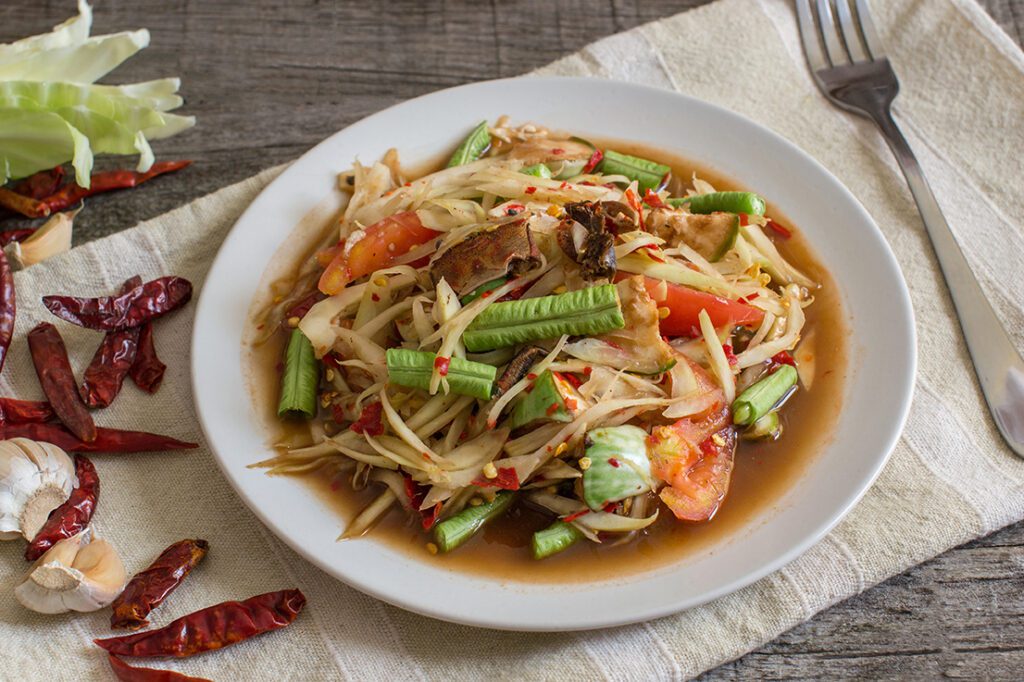

Som Tam – Spicy Papaya Salad
Som Tam, the vibrant and spicy papaya salad, is a beloved dish in Chiang Mai that perfectly encapsulates the essence of Southeast Asian flavors. While commonly associated with Thai cuisine, its roots and popularity in Chiang Mai also reflect significant Lao influences. This section explores the Lao impact on Chiang Mai’s Som Tam, guides you in finding the perfect balance of flavors, and suggests the best spots to enjoy this authentic dish.
The Lao Influence on Chiang Mai’s Som Tam
Som Tam, though widely recognized as a Thai dish, has its origins deeply connected to the culinary traditions of Laos. This influence is particularly evident in Chiang Mai, where Lao cultural and culinary practices have intermingled with local Thai customs, creating a unique regional flavor. The Lao version of Som Tam, known as Tam Mak Hoong in Laos, typically features a more pungent and robust flavor profile compared to its Thai counterpart. This is attributed to the use of fermented fish sauce and crab, which adds depth and intensity to the dish.
In Chiang Mai, Som Tam bridges the flavors of Thai and Lao cuisines, creating a delightful fusion that is both spicy and refreshing. The salad showcases the harmonious blend of cultures in the region and is a testament to the shared culinary heritage of the Lao and Thai people.
Finding the Perfect Balance of Flavors
The art of making Som Tam lies in balancing the five key flavors: sour, spicy, sweet, salty, and umami. This balance is achieved through a careful selection of ingredients and precise seasoning. The primary components include:
Green Papaya: Shredded to provide a crisp, refreshing base.
Chilies: Adjusted according to spice preference.
Lime Juice: Adds a tangy, sour element.
Fish Sauce: Contributes saltiness and umami.
Palm Sugar: Balances with a hint of sweetness.
In Chiang Mai, it’s common to find variations of Som Tam that include additional ingredients like tomatoes, long beans, dried shrimp, or peanuts, further enhancing its complex flavor profile.
Best Spots for Authentic Som Tam
To experience the authentic taste of Som Tam in Chiang Mai, visit:
Som Tam Nua: A popular eatery known for its variety of Som Tam dishes, catering to different tastes and spice levels.
Warorot Market (Kad Luang): Here, you’ll find numerous stalls serving fresh, made-to-order Som Tam, allowing for customization to your flavor preferences.
Som Tam Udon: Offers a more traditional Lao-style Som Tam, known for its authenticity and rich flavors.
Street Food Stalls: Scattered across the city, especially near markets and busy streets, these stalls often serve Som Tam alongside other local favorites like grilled chicken and sticky rice.
Each of these places not only serves delicious Som Tam but also offers a glimpse into the daily culinary life of Chiang Mai’s locals.
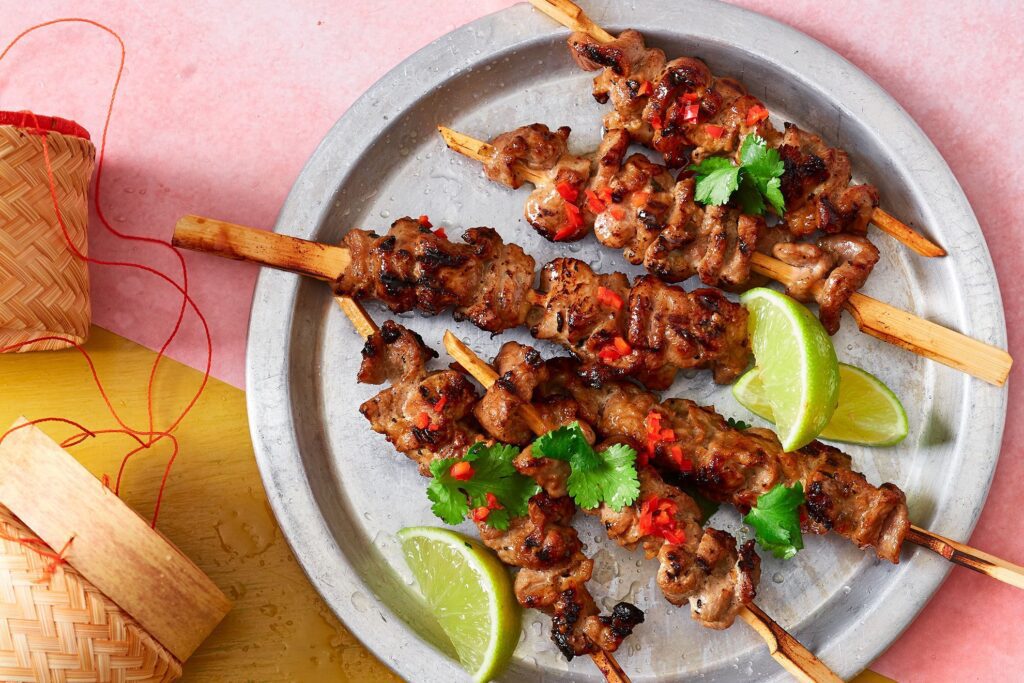

Moo Ping – Grilled Pork Skewers
Moo Ping, the humble yet irresistible grilled pork skewers, is a ubiquitous street snack in Chiang Mai. Revered for its tantalizing aroma and savory taste, Moo Ping is a staple of Thai street cuisine and a must-try for anyone visiting the city. This section delves into the charm of Moo Ping, the art of its preparation, and where to find the best skewers in Chiang Mai.
The Ubiquitous Street Snack: Moo Ping
Moo Ping is not just a popular snack; it’s a culinary emblem of Thailand’s street food scene. Found on almost every street corner, especially in bustling markets and busy streets, Moo Ping vendors can be identified by the fragrant smoke and sizzling sounds emanating from their grills. This dish’s simplicity, accessibility, and affordability make it a favorite among both locals and tourists.
A typical serving of Moo Ping comes with a handful of skewers, each featuring tender pieces of pork marinated in a flavorful mix of herbs and spices. Often accompanied by sticky rice, wrapped in a banana leaf, Moo Ping offers a satisfying, quick meal that encapsulates the essence of Thai street food.
The Art of Marination and Grilling
The secret to the perfect Moo Ping lies in its marination and grilling process. The pork is usually marinated overnight in a mixture of garlic, coriander roots, pepper, soy sauce, and a hint of sugar, allowing the meat to absorb the flavors fully. This marinade not only tenderizes the meat but also infuses it with a harmonious blend of savory, sweet, and slightly spicy flavors.
The grilling of Moo Ping is an art in itself. Skewers are grilled over medium heat, often over charcoal, which imparts a subtle smokiness to the meat. The skewers are continuously turned and basted with coconut milk or the remaining marinade, ensuring the pork remains succulent and develops a beautifully caramelized exterior.
Where to Sample the Best Moo Ping
Chiang Mai boasts numerous spots to enjoy authentic Moo Ping, with each vendor offering their unique twist. Some of the best places to indulge in these grilled pork skewers include:
Chiang Mai Gate Market: This bustling night market is known for its array of street food, including some of the best Moo Ping in the city.
Warorot Market (Kad Luang): Here, you’ll find Moo Ping vendors serving up freshly grilled skewers throughout the day, perfect for a savory snack while exploring the market.
Sunday Walking Street: A haven for food lovers, this market not only offers crafts and souvenirs but also delicious street food, including mouth-watering Moo Ping.
Street Food Stalls near Tha Phae Gate: The area around Tha Phae Gate is a hotspot for street food, with several vendors selling Moo Ping alongside other local favorites.
Lorem ipsum dolor sit amet, consectetur adipiscing elit. Ut elit tellus, luctus nec ullamcorper mattis, pulvinar dapibus leo.
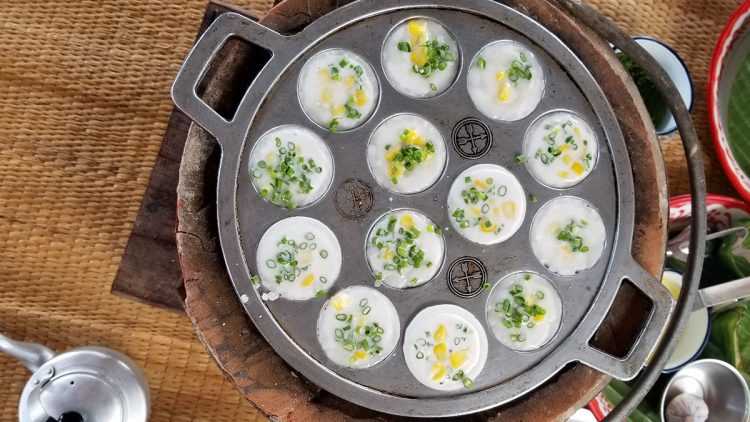

Kanom Krok – Coconut Pancakes
Kanom Krok, the delightful coconut pancakes, represents the sweet side of Thai street food. Adored for their unique texture and sweet, creamy flavor, these small treats are a staple in Chiang Mai’s culinary landscape. This section will explore the allure of Kanom Krok, the intricacies of their preparation, and where to find the best in Chiang Mai.
The Sweet Side of Street Food: Kanom Krok
Kanom Krok is a traditional Thai dessert that holds a special place in the hearts of locals and visitors alike. These bite-sized pancakes are a common sight at street food markets and are known for their distinctive aroma and enticing appearance. Made from a batter of coconut milk and rice flour, Kanom Krok is both gluten-free and irresistibly delicious, making it a favorite among diverse groups of food lovers.
The charm of Kanom Krok lies in its contrasting textures – a crispy, golden-brown shell encasing a soft, creamy center. Often served in pairs, these pancakes are a perfect blend of sweet and savory flavors, embodying the complexity and richness of Thai cuisine.
The Process and Ingredients
The preparation of Kanom Krok is as fascinating as the dish itself. The batter, a crucial element of the recipe, is made from a mix of coconut milk, rice flour, and sometimes a bit of tapioca flour for added crispiness. Sugar, salt, and sometimes pandan juice (for a fragrant twist) are added to the mixture. The batter is then poured into a specially designed, heated griddle with half-moon indentations, giving Kanom Krok its characteristic shape.
The pancakes are cooked until the edges turn crispy and golden, while the center remains soft and custardy. Traditionally, Kanom Krok is filled with a variety of toppings, such as green onions, corn, taro, or even sweet corn, adding layers of flavor and texture.
Ideal Places to Try Kanom Krok
To indulge in the best Kanom Krok in Chiang Mai, consider visiting:
Warorot Market (Kad Luang): This bustling market is a haven for food lovers and hosts several vendors offering freshly made Kanom Krok.
Chiang Mai Gate Market: Known for its wide array of street food, this market is an ideal spot to enjoy Kanom Krok, especially in the evenings.
Sunday Walking Street: As you explore the handicrafts and cultural displays, stop by one of the many food stalls serving this sweet treat.
Night Bazaars: The various night bazaars in Chiang Mai, such as the Anusarn Market, offer an opportunity to taste Kanom Krok alongside other local desserts.
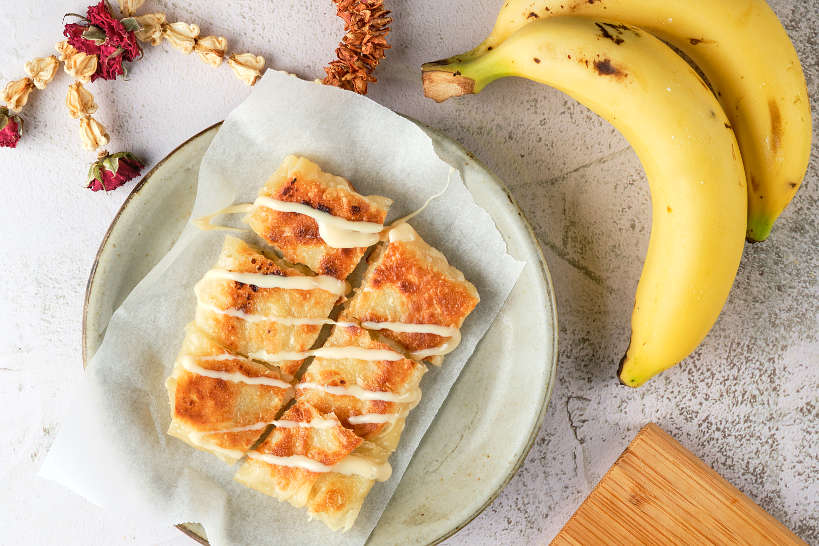

Roti – Thai-Style Pancakes
Roti, a type of Thai-style pancake, offers a delightful fusion of flavors and textures, representing the cultural blend inherent in Thai cuisine. Originally tracing its roots back to India, Roti has been embraced and adapted by Thai culinary traditions to become a beloved snack. In this section, we explore Roti’s journey from India to Thailand, its various sweet and savory incarnations, and where to find the best Roti in Chiang Mai.
Roti’s Journey from India to Thailand
Roti in Thailand is an adaptation of the Indian flatbread of the same name. Brought over by Indian traders and immigrants, it has undergone a culinary transformation in Thailand. While Indian Roti is typically a savory bread served with curries or cooked vegetables, Thai Roti has evolved to become a versatile snack that can be sweet or savory.
In Thailand, particularly in places like Chiang Mai, Roti is made by frying a thin dough on a griddle, resulting in a flaky, crispy exterior with a soft, chewy interior. This cooking style, combined with local flavors and ingredients, has made Thai Roti distinct from its Indian predecessor, showcasing the ability of Thai cuisine to incorporate and reinvent foreign dishes.
Sweet and Savory Variations
Thai Roti is celebrated for its versatility, offering a wide range of flavors to cater to different palates. The sweet variations are particularly popular, often featuring toppings such as condensed milk, sugar, and banana. These sweet Rotis are sometimes finished with a drizzle of chocolate sauce or sprinkled with cocoa powder, making them a favorite among dessert lovers.
On the savory side, Roti can be filled or served with a variety of ingredients, including eggs, minced meat, or even a combination of savory and sweet elements. Some vendors get creative with their offerings, adding local fruits or unconventional spreads to create unique flavor combinations.
Must-Visit Roti Stalls in Chiang Mai
Chiang Mai’s vibrant street food scene includes numerous stalls and eateries where you can enjoy authentic Thai Roti. Some of the must-visit spots include:
Roti Mataba at Anusarn Market: Known for its wide range of both sweet and savory Rotis, this stall is a favorite among locals and tourists alike.
Roti Street Stall near Tha Phae Gate: Here, you can watch the mesmerizing process of Roti-making and enjoy freshly made pancakes with your choice of fillings and toppings.
Night Bazaar: The Roti stalls in Chiang Mai’s Night Bazaar offer a great opportunity to try different variations of this delightful snack as part of your evening exploration.
Street Food Stalls near Warorot Market: Explore the areas around Warorot Market for authentic, locally-loved Roti stalls, serving both traditional and innovative versions of this popular snack.
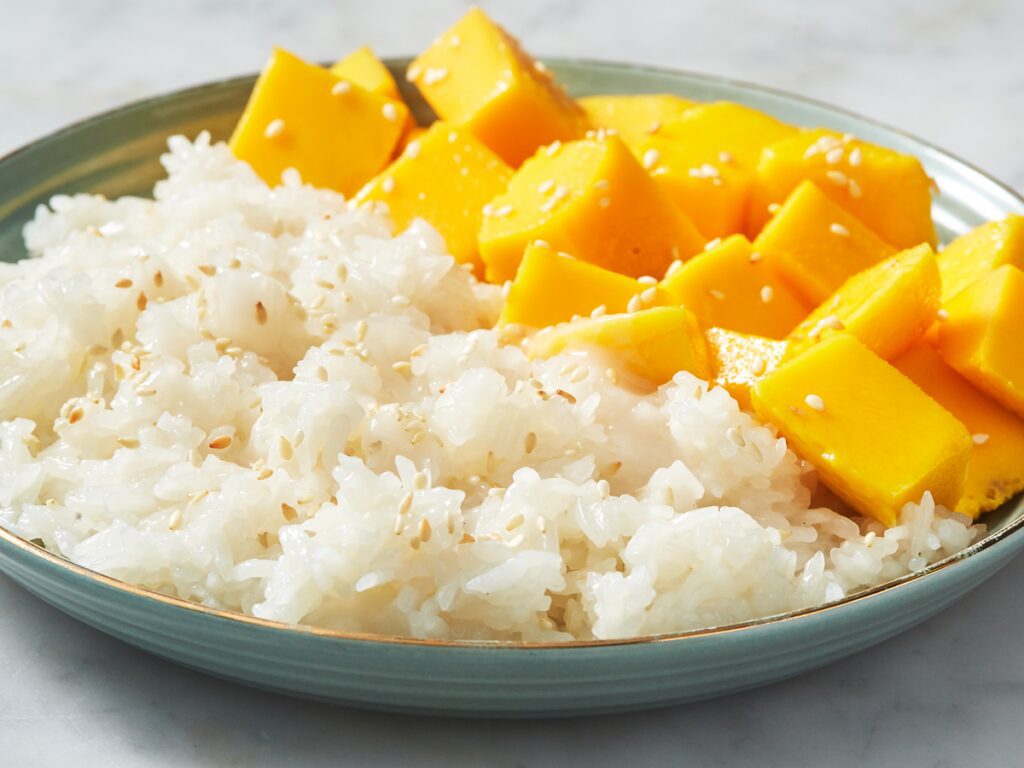

Mango Sticky Rice – A Classic Dessert
Mango Sticky Rice, known in Thai as Khao Niew Mamuang, is a classic dessert that perfectly encapsulates the love affair between two of Thailand’s most beloved ingredients: ripe mangoes and sticky rice. Revered for its simplicity and exquisite taste, this dessert has become synonymous with Thai cuisine. In this section, we explore the harmonious combination of mangoes and sticky rice, the intricacies of choosing the perfect mango, and the best places in Chiang Mai to indulge in this timeless dessert.
The Love Affair Between Mangoes and Sticky Rice
Mango Sticky Rice is a delectable blend of sweet, ripe mangoes paired with glutinous sticky rice, often drizzled with a sweet coconut milk sauce. The dish’s allure lies in its contrasts – the warm, soft rice complements the cool, tender mango, while the mild sweetness of the rice balances the fruit’s natural zest.
This dessert is not just a treat for the palate but also a representation of Thailand’s agricultural richness. Mangoes, particularly the Nam Dok Mai variety, are a national treasure, celebrated for their sweet, juicy flesh. Paired with sticky rice, a staple in Thai households, Mango Sticky Rice is a celebration of local produce and culinary artistry.
The Art of Selecting the Perfect Mango
The key to a perfect Mango Sticky Rice lies in the quality of the mango. The ideal mango for this dish is ripe, but not overly so, with a sweet aroma and a firm yet yielding flesh. Nam Dok Mai mangoes are often preferred for their sweet, buttery texture and minimal fiber.
Selecting the right mango involves a gentle squeeze – it should give slightly under pressure, indicating ripeness. The skin should be bright and smooth, without any blemishes. A ripe mango will also have a sweet, fragrant smell at the stem end.
Top Spots for Mango Sticky Rice
Chiang Mai, with its abundance of fresh produce, is an ideal place to enjoy Mango Sticky Rice. Some of the top spots include:
Warorot Market (Kad Luang): This market is a hub for fresh fruits and traditional Thai desserts, including high-quality Mango Sticky Rice.
Maewaree Fruit Shop: Located on Nimmanhaemin Road, this shop is renowned for its delicious Mango Sticky Rice, made with premium-quality mangoes.
Night Bazaars: The various night bazaars in Chiang Mai, such as the one along Chang Klan Road, offer an opportunity to enjoy this dessert in a lively, bustling atmosphere.
Local Street Food Stalls: Scattered throughout the city, many street food vendors and small eateries serve authentic Mango Sticky Rice, often at very affordable prices.
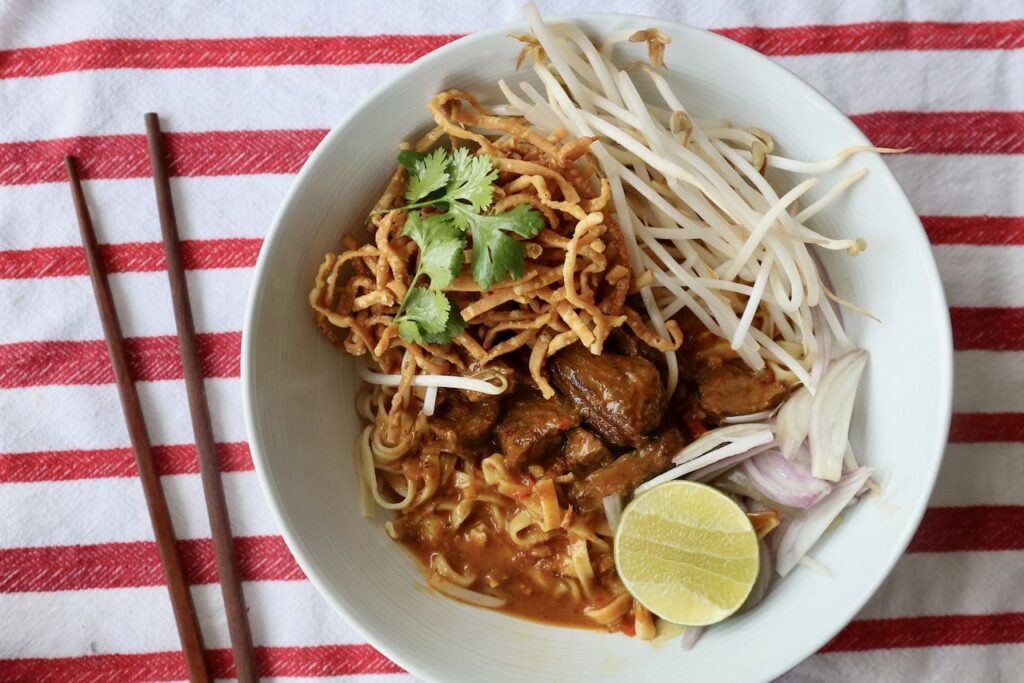

Chiang Mai Noodles – A Local Twist
Chiang Mai, a city known for its rich culinary landscape, offers a unique twist on traditional Thai noodle dishes. These local specialties reflect the blend of historical influences and regional flavors, making Chiang Mai a noodle lover’s paradise. In this section, we will explore the distinctive noodle dishes of Chiang Mai, the various types available, and where to find the most authentic and delightful noodle experiences in the city.
Unique Noodle Dishes of Chiang Mai
Chiang Mai’s noodle dishes stand out for their unique flavors and ingredients, with some of the most notable being:
Khao Soi: Perhaps the most famous Chiang Mai noodle dish, Khao Soi is a creamy, curry-based soup with egg noodles, usually served with chicken or beef, and topped with crispy fried noodles, pickled mustard greens, shallots, and lime.
Kanom Jeen Nam Ngiao: A dish with Burmese influences, featuring thin rice noodles served in a spicy tomato-based broth with minced pork, tomatoes, and fermented soybeans, often garnished with fresh herbs and vegetables.
Ba Mee Moo Dang: This dish includes egg noodles served with slices of barbecued pork (moo dang), often accompanied by wontons and vegetables, in a clear broth or dry style.
These noodle dishes offer a taste of Chiang Mai’s culinary diversity, each with its unique set of flavors and textures.
Sampling Different Noodle Varieties
To truly appreciate Chiang Mai’s noodle cuisine, it’s essential to sample the various types available. Each dish offers a different combination of flavors and ingredients:
For spice lovers, Khao Soi’s rich, coconut-curry broth provides a warming and flavorful experience.
For those who prefer tangy and spicy flavors, Kanom Jeen Nam Ngiao’s tomato-based broth is a perfect choice.
For a more classic taste, Ba Mee Moo Dang offers a comforting bowl of noodles with savory barbecued pork.
Sampling these different varieties allows you to appreciate the nuances of Northern Thai noodle cuisine.
Where to Find the Best Noodle Experiences
Chiang Mai is dotted with eateries ranging from street stalls to established restaurants where you can enjoy authentic noodle dishes:
Khao Soi Lam Duan Fah Ham: Widely regarded as one of the best places for Khao Soi, this restaurant offers a rich and flavorful experience.
Kanom Jeen Sanpakoi: This eatery is known for its Kanom Jeen Nam Ngiao, serving it with a variety of fresh herbs and vegetables.
Ba Mee Jub Kang: A popular spot for Ba Mee Moo Dang, known for its tender barbecued pork and flavorful broth.
Street Food Stalls around Warorot Market: Explore the area around Warorot Market for a wide range of noodle dishes, served fresh and full of local flavors.
Conclusion
The noodle dishes of Chiang Mai are a testament to the city’s rich cultural tapestry and culinary innovation. From the creamy, spicy Khao Soi to the tangy Kanom Jeen Nam Ngiao, each dish offers a unique window into the flavors of Northern Thailand. Exploring these noodle varieties is not just about satisfying hunger; it’s about experiencing the essence of Chiang Mai’s food culture.


Grilled Fish and Seafood in Chiang Mai
While Chiang Mai might be landlocked, its street food scene boasts an impressive array of grilled fish and seafood, bringing a taste of the sea to the mountains. This section explores the bustling street-side grilling culture in Chiang Mai, offers tips on tasting and seasoning these grilled delights, and guides you to the best spots for indulging in fresh, savory seafood.
Street-Side Grilling: Fish and Seafood in Chiang Mai
The streets of Chiang Mai come alive with the aroma of grilled fish and seafood, a testament to the city’s diverse culinary offerings. From bustling markets to roadside stalls, vendors expertly grill a variety of seafood, including fish, prawns, squid, and shellfish. These dishes are not only delicious but also a reflection of the adaptability of Thai cuisine, incorporating flavors and techniques from different regions.
Grilled fish, often a whole tilapia or catfish, is a popular choice. It’s typically marinated with aromatic herbs like lemongrass, kaffir lime leaves, and turmeric, then slowly grilled to perfection. The result is a dish with a crispy exterior and tender, flavorful flesh, often served with a spicy dipping sauce that complements the smoky flavors.
Tasting and Seasoning Tips
When sampling grilled fish and seafood in Chiang Mai, consider these tips to enhance your experience:
Look for Freshness: Fresh seafood is key to a good grilled dish. Look for clear eyes and bright, firm flesh in fish, and vibrant, intact shells in shellfish.
Season Boldly: Thai cuisine is known for its bold flavors. Don’t hesitate to try the various dipping sauces provided, ranging from sweet and tangy to fiery hot.
Balance the Flavors: Accompany your grilled seafood with sides like sticky rice, fresh vegetables, or a papaya salad to balance the rich, smoky flavors.
Experiment with Condiments: Experiment with condiments like chili flakes, garlic, and lime juice, often available at Thai street food stalls, to customize the dish to your taste.
Best Locations for Fresh, Grilled Delights
For the best grilled fish and seafood in Chiang Mai, consider visiting these locations:
Chiang Mai Gate Market: In the evening, this market transforms into a street food haven, with several stalls offering freshly grilled seafood.
Warorot Market (Kad Luang): A great place to explore a wide range of Thai food, including grilled fish and seafood, cooked right in front of you.
Riverside Restaurants: Some restaurants along the Ping River specialize in seafood dishes, providing a scenic backdrop to enjoy a grilled feast.
Nimmanhaemin Road: This trendy area has several eateries and street vendors serving up delicious grilled seafood, perfect for an evening meal.
Conclusion
Grilled fish and seafood in Chiang Mai are a culinary adventure, offering a taste of Thai coastal cuisine in the heart of the north. Whether you’re exploring the lively street markets or dining at a riverside restaurant, the experience of savoring these grilled delicacies is a delightful aspect of the city’s food culture.


Insect Delicacies – For the Adventurous
In Chiang Mai, the adventurous foodie can explore an unconventional yet fascinating aspect of local cuisine – edible insects. A staple in many cultures worldwide, including Northern Thailand, insects are not only a sustainable food source but also offer unique flavors and textures. This section delves into the world of edible insects, discusses their health benefits and preparation methods, and suggests where to try these dishes safely.
Exploring the World of Edible Insects
In Chiang Mai, a variety of insects are considered delicacies, each offering a distinct culinary experience. Commonly consumed insects include crickets, grasshoppers, bamboo worms, and even silkworm larvae. These are often found at local markets and street food stalls, showcasing the city’s adventurous culinary spirit.
Consuming insects might be a novel idea for many visitors, but in Chiang Mai, it’s a tradition rooted in local culture and history. These dishes are often enjoyed as snacks, seasoned with local herbs and spices, and fried to a crisp texture, making them a surprisingly tasty treat.
Health Benefits and Preparation Methods
Edible insects are not only a unique culinary experience but also a nutritious one. They are high in protein, vitamins, minerals, and fiber, while being low in fat and carbohydrates. This makes them a healthy alternative to conventional meats.
The most common preparation method for edible insects in Chiang Mai is frying. This method brings out a nutty flavor and a crunchy texture that is appealing to many. Insects are typically seasoned with Thai spices like lemongrass, kaffir lime leaves, and chili, enhancing their natural flavors. They can be eaten whole or used as an ingredient in other dishes.
Where to Try Insect Dishes Safely
For those looking to safely try insect dishes in Chiang Mai, consider these spots:
Chiang Mai Night Markets: Places like the Night Bazaar and Sunday Walking Street offer a safe and accessible way for tourists to try fried insects, usually served by experienced vendors who prepare them hygienically.
Local Street Food Stalls: Look for busy stalls that attract a crowd, as high turnover usually means fresher, safely prepared insects.
Specialty Restaurants: Some restaurants in Chiang Mai may offer gourmet insect dishes, providing a more refined way to sample these delicacies.
Food Tours: Joining a guided food tour can be a great way to explore edible insects, as experienced guides can lead you to the best and safest places to try them.
Conclusion
Edible insects in Chiang Mai offer a unique glimpse into an alternative side of Thai cuisine, one that challenges and delights the palate. For the adventurous eater, trying these insect delicacies can be a memorable part of the culinary journey, offering a combination of novel flavors, textures, and nutritional benefits. As with any adventurous eating, it’s important to try these dishes from reputable sources to ensure a safe and enjoyable experience.
Conclusion: Savoring the Streets of Chiang Mai
As our gastronomic journey through the streets of Chiang Mai comes to a close, we reflect on the city’s diverse and vibrant culinary landscape. From the creamy bowls of Khao Soi to the adventurous bites of edible insects, Chiang Mai’s street food scene is a vivid tapestry of flavors, textures, and aromas. This conclusion offers insights on how to create a personalized street food adventure and emphasizes the importance of sustainable and responsible food tourism.
Reflecting on the Diverse Culinary Landscape
Chiang Mai’s street food offers a journey through the history and culture of Northern Thailand. Each dish, whether a humble plate of Moo Ping or an exotic serving of insect delicacies, tells a story of local traditions, regional ingredients, and culinary innovation. The city’s streets are a melting pot where ancient recipes meet modern tastes, and where local flavors blend seamlessly with international influences.
The experience of street food in Chiang Mai is not just about satisfying hunger; it’s an exploration of the city’s soul. It’s about the connection between the food, the people who prepare it, and those who enjoy it, creating a shared experience that transcends language and culture.
How to Create a Personalized Street Food Adventure
Creating your own street food adventure in Chiang Mai involves a mix of planning and spontaneity:
Research Popular Dishes: Start by identifying must-try local dishes and popular food spots.
Explore Beyond the Guidebook: Allow room for spontaneous discoveries. Sometimes, the best experiences come from stumbling upon a busy stall or a hidden eatery.
Embrace Variety: Sample a range of dishes to experience the full spectrum of flavors Chiang Mai offers.
Engage with Locals: Don’t hesitate to ask locals for recommendations. They often know the best spots and hidden gems.
Consider Dietary Preferences: Chiang Mai’s street food scene caters to various dietary preferences, including vegetarian and vegan options.
Encouraging Sustainable and Responsible Food Tourism
As you indulge in the culinary delights of Chiang Mai, it’s important to practice sustainable and responsible food tourism:
Support Local Vendors: Choose to eat at local stalls and eateries, as this supports the local economy and small businesses.
Be Mindful of Resources: Avoid wastage of food and disposables. Opt for reusable utensils if possible.
Respect Local Customs and Culture: Be sensitive to cultural norms, especially when sampling exotic dishes like insects.
Promote Environmental Sustainability: Patronize vendors who use sustainable practices and local ingredients.
Conclusion
The street food experience in Chiang Mai is as enriching as it is delicious. It offers a window into the heart of Thai culture and cuisine, inviting travelers not just to taste but to immerse themselves in a world of culinary wonders. By exploring responsibly and sustainably, you not only enjoy the flavors of Chiang Mai but also contribute to preserving its unique culinary heritage.








